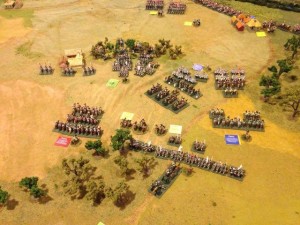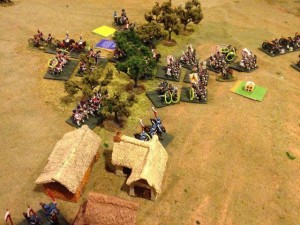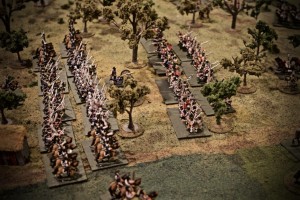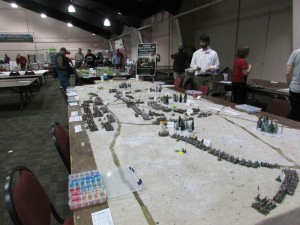1. You just launched Et sans résultat! at Little Wars 2015 – How’d the launch go?
Awesome. Just awesome. We ran two games of ESR – the Battle of Eylau. At the height of things we had seven players and eight people observing the game, lot of interest. Each side had one veteran player who’d partaken in play testing acting as the army commander. Otherwise all the players were new to the game. Somewhat surprisingly the games resolved pretty historically, the Russians were very beat up but the French were exhausted after making very slow progress.
Sales of ESR were strong, the games we ran were terrific and the convention as a whole was a ton of fun! Leading up to the convention we sold out of our first print run during pre-orders, following the convention our second print run was nearly gone. There were a striking number of people who were really happy to see a new take on Napoleonics and that’s exciting because it might be the least approachable period for new players and we really want to make Napoleonics approachable with ESR.
2. Let’s get right to it: Does anyone on this side of the pond know how to pronounce Et sans résultat?
Well, my wife does but she speaks French… Mostly I refer to the game as ‘ESR’. Many games get referred to by letters – Does anyone call DBA by its actual name? – so no one should feel bad saying ‘ESR’ instead of learning to pronounce ‘Eh sa ree-sul-ta’.
3. So what made you pick Et sans résultat! as the name?
The name has a nice period feel to it, it’s French, taken from a quote by Marshal Ney at Eylau in 1807. It translates to “And with no result!” He was talking about the fantastic loss of life over ground of no value and a battle that didn’t accomplish anything. I was drawn to it because that’s largely what most of war is: waste without result. But we play wargames as both a pass time and a way to understand history, so it became an ironic pronouncement: War may be without results, but wargames need not be.
4. Tell us a little about yourself, how’d you get involved in wargaming, besides the Napoleonic period what other periods do you enjoy?
When I was a kid in grade school my folks took me to visit Gettysburg, after that trip I was just enamored by history. Started looking to make Civil War dioramas and then by happenstance met a guy at a hobby shop who says, “Oh no, you don’t want to make static models, you want to play wargames.” He was right. I’ve been wargaming ever since.
The American Revolution, Napoleonics, American Civil War, World War II, BattleTech… I’ve been getting really interested in the Seven Years War and Ancients too the last handful of years. My local group and I play a pretty wide variety of games, old and new, skirmish, tactical, grand tactical… historical, sci-fi.
5. What attracts you to the Napoleonic period, are there specific personalities or facets?
For me different periods are characterized by completely different aspects. The Napoleonic Wars, for me, are big. The huge undertakings, the immense scope of it all. For me where the Napoleonic Wars happen is at the senior command level. The personalities of the period are just astounding, I’m an admitted fan of Napoleon but all of the men of the period are really interesting from the Marshals of France to the Allied generals – many of whom weren’t as bad as we assume they were for losing. I’m really drawn to the 1814 Campaign of France. I’m drawn to long odds and lost causes. And frankly, it is everything to everyone: Napoleon is ever present, the Guard are always deployed, the Allies always have the upper hand. All the things a wargamer wants get balanced into the 1814 campaign.
6. Getting into ESR – What makes ESR a unique game, how is it any different from the literally thousands of other Napoleonic wargames?
It’s hard to maintain useful objectivity when you design something. In short ESR combines the approachability of beer & pretzel games with concepts you normally only see in complex simulation games. You’ve got concepts like divisional fatigue and paced verse intense artillery fire, and mass cavalry charges but it’s all done with charts that fit on the front and back of a single page.
I think ESR is unique because of the key characteristics it brings together:
First is that ESR is really approachable. The charts are two-pages, front and back of a single sheet, the turn sequence is six phases and the charts are presented in the order they are used in the turn. The procedures are straight forward, special cases almost don’t exist. The parameters of orders are spelled out on the order cards. The charts include the procedures. ESR is really a game you can walk up and learn.
Next is that ESR is internally consistent – and I mean that in a big way. The terminology is consistent, the mechanics are consistent. You aren’t going to sit down to play and find four contradictions that you have to overlook or decide how to deal with yourself. This means you’ll struggle less to interpret rules, the statements are succinct and the meanings clear. There also aren’t exceptions scattered throughout multiple sections, if you want to read about artillery fire there is one spot that covers it, one chart that is used and one phase it occurs in.
Last is that ESR is perspective based – most wargames don’t function from a specific perspective. In ESR a player is a corps commander, not a corps commander, a division commander, a brigade commander, a regimental commander and a battalion chief. By stripping away these other levels the player gets to focus on and enjoy the grand tactical decision making that they read about these great captains orchestrating.
What this approachable simplicity allows is a lot of detail, a lot more than you’d expect from a game with a two-page reference sheet.
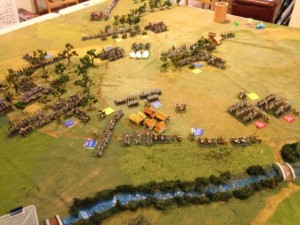
ESR battles have a great “look” to them! Here is another picture from one the author’s most recent games.
7. ESR has some new concepts and a lot of new takes on existing concepts, can you highlight some of them for us?
Sure, here’s just a couple…
ESR uses persistent orders that stay in effect turn over turn until something causes them to change, like the activation of a new order or a large setback. To keep the overhead down but still provide some structure ESR uses cards: order, movement and objective. It gets rid of the radio control that dominates a lot of fast play games but avoids the complication of written orders.
Skirmishing is a real challenge in wargames, most of the time it ends up either feeling pointless or just another complicated combat phase. In ESR players have to tackle skirmishing from a corps commander’s perspective. The challenge is how to gain superiority over your opponent without expending so many resources that winning becomes more painful than losing.
Assessments are really where games are decided. Time spent in close proximity of the enemy, sustained artillery bombardments, routed units, and other dispositions fatigue divisions. Eventually, with enough sustained pressure divisions will break. That’s the real focus of ESR, you’re not trying to kill men or run off individual units, you’re trying to make the position of enemy divisions untenable so they break.
8. You mentioned order cards, some players are going to want to know if ESR uses a lot of tabletop markers?
No, in fact there was a lot of work to get rid of tabletop markers as much as possible. When I started ESR had something like 15 different tabletop markers for different things, was stupid. A very cool thing about ESR: there aren’t any traditional condition markers for routed or shaken, winded or blown, depleted or silenced. Instead, the condition of a unit is indicated by its relative location. The best example is the Reformation Area. Between 400-900 yards beyond a division’s battle line is the Reformation Area, the rear area, the rally point. When a unit routs, it goes there. When cavalry recall, they go there. When a battery depletes out, it goes there. So you don’t have units scattered all over the table and players asking, “Is that one routed? Where did its rout marker go?”
There are some markers, couldn’t get away from it completely. Each division typically receives three order cards unless it is defending, resting or in reserve. These cards don’t have to be on the table but do need to be linked back to their division somehow. Some play testers constructed small boxes with slots for each corps, labeled each slot in the box and then placed the orders for the corresponding division in the appropriate slot. That allowed them to keep the table almost completely clear of anything but figures and terrain. My local group is more pragmatic than aesthetic so we mounted order card holders onto the stands of division and corps commanders. When you move the division commander his orders come along with. It actually has a kind of a neat visual effect that makes the table look like an illustrated map out of an Osprey book or a WW2 style sand table with labels poking up at the sky.
9. How do players get the order cards, buy them, download print them, what?
We’ve got a downloads section on The Wargaming Company website. Charts, gauges for the angle of artillery fire and cavalry charges, as well as order cards are all available for free download so yes – you can download them and print them. You can also buy an “ESR Player’s Kit” which supplies enough charts, orders, and gauges for at least 2-3 players to share. The material used to print the ESR Player’s Kit is “polyester paper” which is a highly durable product from Xerox, it’s very difficult to tear, liquid resistant, and even hard to crease. You can spill a beer or coffee on it and just pour it right of, wipe it off with a rag and go back to using it. Should be good for wargaming tables where order cards and charts get tucked away here and there, leaned on, spilled on…
10. You gave an overview of some of the mechanics but what about nitty gritty stuff – how does combat work?
Combat is deceivingly straight forward. What I mean is, it’s really simplistic. The scope of ESR isn’t tactical unit fighting – it is coordination of divisions. So in keeping with that, when units hit, they roll dice, there are a couple modifiers and a result. We tested a *lot* of different combat systems. More detail, less detail, batch systems that resolved a bunch of units at once, macro systems where a whole division achieved a result – none of them were satisfactory. I didn’t want to create a game, say that battalions existed on the tabletop and then resolve everything at the division level. To me that would have said there are no battalions, there are just stands in a division. That’s a different game – in fact I’ve played that game and it is fun – but it isn’t the game I wanted to write.
The long and short is, when units touch they fight during combat. Order of resolution is attacker’s right to attacker’s left. If both sides are attacking I trust the players can work out something amicable or resort to flipping a coin because this is not a make or break thing. Both sides apply their modifiers and add 2D6. You follow the results table, then onto the next one. If you’ve got two units in contact with one unit, same procedure, if that lone unit wins the first combat he’ll fight again against his second opponent, if not, he won’t because he’ll be located somewhere towards the rear.
11. If our readers want some more in-depth understanding of what to expect from ESR, how can they find out more?
www.thewargamingcompany.com is our website and we’re really trying to post as much information as we can about what to expect from game play, what the concepts and mechanics work like. So often when we buy wargames – unless we’re able to flip through the book in the store – we really have no idea what to expect outside a couple line description.
On our website there’s an announcements mailing list to sign up for that will keep you up-to-date about new releases, convention games and other news. There’s a gallery of play test photos so that you can see what many of the ESR play tests looked like and have an idea of if ESR fits your impression of how a Napoleonic battle should look. But most importantly there are useful descriptions about how the mechanics work. The ‘Basics’ page outlines briefly every topic a wargamer wants to know before they buy a set of rules: from ground scale options to how ESR handles command, movement, skirmishing, artillery, combat, etc… Frankly, the intent of ‘Basics’ was to give a new player enough information that they could show up to a game, read the charts and be able to participate without a lot of active coaching.
12. The Wargaming Company is a pretty audacious name for a new venture – have big plans?
Well, we’ve got big hopes. Later this year the first scenario book for ESR will be released, it really isn’t necessarily *for* ESR because you could use it with nearly any set of Napoleonic rules but we hope people like it and like ESR enough that they’d use them together. After that there are more scenario books on the drawing board and plans for other areas and periods but those don’t have timelines yet. If wargamers like what we do, then you’ll see more of it. “We” is pretty small, my wife and I. She runs the website and I design the games. Haven’t figured out which of us is going to be the accounting department yet – we’d better get that solved! (HINT: It will probably be her.)
13. Where can people buy a copy of ESR?
Well, for some, their local neighborhood gaming shop. We’re reaching out to gaming stores across the US because the nicest way to buy a book is still to hold it in your hand and page through it before you purchase. But since more and more retail happens online you can also buy ESR via The Wargaming Company Store or from Amazon, Scale Creep, The War Store, On Military Matters, or Noble Knight.
On our website you can see a current list of places to buy ESR and other Wargaming Company products like the ESR Players’ Kit. We’ve also got UK availability through Magister Militum and Caliver Books because we’ve had a lot interest from across the pond both on the island and on the continent.
14. What form does ESR come in?
Our initial release of ESR is a printed book, coil bound, all told 90 pages, about half of that is made up of rating recommendations for commanders and troops for players who like those, for players who hate those there are some broad base recommendations as well. The charts make up the back cover of the rule book. The book is heavy print stock and feels quite substantial, the covers use that polyester paper so it’s durable and protected. Some designers go with hardcover but I made a conscious choice to avoid it, it looks great in the store but it is really expensive and hard to use around the gaming table where you’ve got limited space. Besides – when you flip open to a page you want to be able to set the rule book down without it closing on you. The coil bound is just really practical, might not look as sexy on the store shelf but it is way more useful in your gaming room.
15. Will there be a digital release?
There will be a PDF release of ESR. We don’t have a timeline. The delay is so that I can layout out the rules specifically for the people who only buy PDF, the worst thing about buying something you plan to print is considering how much ink you’ll spend printing it, so I’m trying to make that as painless as possible. The PDF will be slightly cheaper than the printed copy but anyone who’s bought a printed copy of ESR will have the option to get the PDF for a very reasonable deal so if you want both – and most of us do – don’t hesitate to buy the printed book, we’ll have the PDF for you.
All of it stems from ESR being a perspective based game and the goal of making it approachable. I accepted that ESR couldn’t be a classic simulation because they aren’t approachable. And I didn’t want to make a beer & pretzels sorta fast-play thing because while many of those make decent games I wanted something more connected to history. So I knew I’d be trying to meld the simplicity of fast-play with the detail of simulation. The guiding principal of what to keep and what to exclude became all about the player’s perspective: the player is a corps commander.
For more information and to purchase the rules, here is a link to the Wargaming Company, Llc’s website – link
Good Gaming! CBB

